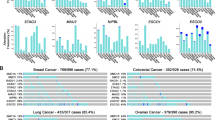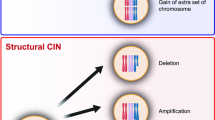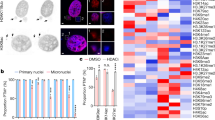Abstract
Many tumors exhibit elevated chromosome mis-segregation termed chromosome instability (CIN), which is likely to be a potent driver of tumor progression and drug resistance. Causes of CIN are poorly understood but probably include prior genome tetraploidization, centrosome amplification and mitotic checkpoint defects. This study identifies epigenetic alteration of the centromere as a potential contributor to the CIN phenotype. The centromere controls chromosome segregation and consists of higher-order repeat (HOR) alpha-satellite DNA packaged into two chromatin domains: the kinetochore, harboring the centromere-specific H3 variant centromere protein A (CENP-A), and the pericentromeric heterochromatin, considered important for cohesion. Perturbation of centromeric chromatin in model systems causes CIN. As cancer cells exhibit widespread chromatin changes, we hypothesized that pericentromeric chromatin structure could also be affected, contributing to CIN. Cytological and chromatin immunoprecipitation and PCR (ChIP–PCR)-based analyses of HT1080 cancer cells showed that only one of the two HORs on chromosomes 5 and 7 incorporate CENP-A, an organization conserved in all normal and cancer-derived cells examined. Contrastingly, the heterochromatin marker H3K9me3 (trimethylation of H3 lysine 9) mapped to all four HORs and ChIP–PCR showed an altered pattern of H3K9me3 in cancer cell lines and breast tumors, consistent with a reduction on the kinetochore-forming HORs. The JMJD2B demethylase is overexpressed in breast tumors with a CIN phenotype, and overexpression of exogenous JMJD2B in cultured breast epithelial cells caused loss of centromere-associated H3K9me3 and increased CIN. These findings suggest that impaired maintenance of pericentromeric heterochromatin may contribute to CIN in cancer and be a novel therapeutic target.
This is a preview of subscription content, access via your institution
Access options
Subscribe to this journal
Receive 50 print issues and online access
$259.00 per year
only $5.18 per issue
Buy this article
- Purchase on Springer Link
- Instant access to full article PDF
Prices may be subject to local taxes which are calculated during checkout





Similar content being viewed by others
References
Alonso A, Hasson D, Cheung F, Warburton PE . (2010). A paucity of heterochromatin at functional human neocentromeres. Epigenetics Chromatin 3: 6.
Amato A, Schillaci T, Lentini L, Di Leonardo A . (2009). CENPA overexpression promotes genome instability in pRb-depleted human cells. Mol Cancer 8: 119.
Archidiacono N, Antonacci R, Marzella R, Finelli P, Lonoce A, Rocchi M . (1995). Comparative mapping of human alphoid sequences in great apes using fluorescence in situ hybridization. Genomics 25: 477–484.
Bannister AJ, Zegerman P, Partridge JF, Miska EA, Thomas JO, Allshire RC et al. (2001). Selective recognition of methylated lysine 9 on histone H3 by the HP1 chromo domain. Nature 410: 120–124.
Bergmann JH, Rodriguez MG, Martins NM, Kimura H, Kelly DA, Masumoto H et al. (2011). Epigenetic engineering shows H3K4me2 is required for HJURP targeting and CENP-A assembly on a synthetic human kinetochore. EMBO J 30: 328–340.
Bernard P, Maure JF, Partridge JF, Genier S, Javerzat JP, Allshire RC . (2001). Requirement of heterochromatin for cohesion at centromeres. Science 294: 2539–2542.
Bourgo RJ, Siddiqui H, Fox S, Solomon D, Sansam CG, Yaniv M et al. (2009). SWI/SNF deficiency results in aberrant chromatin organization, mitotic failure, and diminished proliferative capacity. Mol Biol Cell 20: 3192–3199.
Cahill DP, Kinzler KW, Vogelstein B, Lengauer C . (1999). Genetic instability and darwinian selection in tumours. Trends Cell Biol 9: M57–M60.
Cardinale S, Bergmann JH, Kelly D, Nakano M, Valdivia MM, Kimura H et al. (2009). Hierarchical inactivation of a synthetic human kinetochore by a chromatin modifier. Mol Biol Cell 20: 4194–4204.
David G, Dannenberg JH, Simpson N, Finnerty PM, Miao L, Turner GM et al. (2006). Haploinsufficiency of the mSds3 chromatin regulator promotes chromosomal instability and cancer only upon complete neutralization of p53. Oncogene 25: 7354–7360.
David G, Turner GM, Yao Y, Protopopov A, DePinho RA . (2003). mSin3-associated protein, mSds3, is essential for pericentric heterochromatin formation and chromosome segregation in mammalian cells. Genes Dev 17: 2396–2405.
Ekwall K, Olsson T, Turner BM, Cranston G, Allshire RC . (1997). Transient inhibition of histone deacetylation alters the structural and functional imprint at fission yeast centromeres. Cell 91: 1021–1032.
Esteller M . (2008). Epigenetics in cancer. N Engl J Med 358: 1148–1159.
Finelli P, Antonacci R, Marzella R, Lonoce A, Archidiacono N, Rocchi M . (1996). Structural organization of multiple alphoid subsets coexisting on human chromosomes 1, 4, 5, 7, 9, 15, 18, and 19. Genomics 38: 325–330.
Fodor BD, Kubicek S, Yonezawa M, O'Sullivan RJ, Sengupta R, Perez-Burgos L et al. (2006). Jmjd2b antagonizes H3K9 trimethylation at pericentric heterochromatin in mammalian cells. Genes Dev 20: 1557–1562.
Gonzalo S, Garcia-Cao M, Fraga MF, Schotta G, Peters AH, Cotter SE et al. (2005). Role of the RB1 family in stabilizing histone methylation at constitutive heterochromatin. Nat Cell Biol 7: 420–428.
Grimes BR, Babcock J, Rudd MK, Chadwick B, Willard HF . (2004). Assembly and characterization of heterochromatin and euchromatin on human artificial chromosomes. Genome Biol 5: R89.
Grimes BR, Steiner CM, Merfeld-Clauss S, Traktuev DO, Smith D, Reese A et al. (2009). Interphase FISH demonstrates that human adipose stromal cells maintain a high level of genomic stability in long-term culture. Stem Cells Dev 18: 717–724.
Guenatri M, Bailly D, Maison C, Almouzni G . (2004). Mouse centric and pericentric satellite repeats form distinct functional heterochromatin. J Cell Biol 166: 493–505.
Haaf T, Ward DC . (1994). Structural analysis of alpha satellite DNA and centromere proteins using extended chromatin and chromosomes. Hum Mol Genet 3: 697–709.
Herbert BS, Wright WE, Shay JW . (2002). p16(INK4a) inactivation is not required to immortalize human mammary epithelial cells. Oncogene 21: 7897–7900.
Hochreiter AE, Xiao H, Goldblatt EM, Gryaznov SM, Miller KD, Badve S et al. (2006). Telomerase template antagonist GRN163L disrupts telomere maintenance, tumor growth, and metastasis of breast cancer. Clin Cancer Res 12: 3184–3192.
Hulsebos T, Schonk D, van Dalen I, Coerwinkel-Driessen M, Schepens J, Ropers HH et al. (1988). Isolation and characterization of alphoid DNA sequences specific for the pericentric regions of chromosomes 4, 5, 9, and 19. Cytogenet Cell Genet 47: 144–148.
Kops GJ, Weaver BA, Cleveland DW . (2005). On the road to cancer: aneuploidy and the mitotic checkpoint. Nat Rev Cancer 5: 773–785.
Lee C, Wevrick R, Fisher RB, Ferguson-Smith MA, Lin CC . (1997). Human centromeric DNAs. Hum Genet 100: 291–304.
Lingle WL, Barrett SL, Negron VC, D'Assoro AB, Boeneman K, Liu W et al. (2002). Centrosome amplification drives chromosomal instability in breast tumor development. Proc Natl Acad Sci USA 99: 1978–1983.
Liu G, Bollig-Fischer A, Kreike B, van de Vijver MJ, Abrams J, Ethier SP et al. (2009). Genomic amplification and oncogenic properties of the GASC1 histone demethylase gene in breast cancer. Oncogene 28: 4491–4500.
Lohse B, Kristensen JL, Kristensen LH, Agger K, Helin K, Gajhede M et al. (2011). Inhibitors of histone demethylases. Bioorg Med Chem 19: 3625–3636.
Malorni L, Shetty PB, Hilsenbeck SG, Rimawi MF, Elledge RM, De Angelis C et al. (2010). Triple-negative breast cancers: biomarkers and outcomes. J Clin Oncol 28 (15 Suppl): 10621.
Mitelman F, Johansson B, Mertens F . Catalog of Chromosome Aberrations in Cancer, 5th edn. Wiley-Liss: New York, USA, 1994.
Mravinac B, Sullivan LL, Reeves JW, Yan CM, Kopf KS, Farr CJ et al. (2009). Histone modifications within the human X centromere region. PLoS One 4: e6602.
Nakano M, Cardinale S, Noskov VN, Gassmann R, Vagnarelli P, Kandels-Lewis S et al. (2008). Inactivation of a human kinetochore by specific targeting of chromatin modifiers. Dev Cell 14: 507–522.
Ohzeki J, Nakano M, Okada T, Masumoto H . (2002). CENP-B box is required for de novo centromere chromatin assembly on human alphoid DNA. J Cell Biol 159: 765–775.
Palmer DK, O'Day K, Wener MH, Andrews BS, Margolis RL . (1987). A 17-kD centromere protein (CENP-A) copurifies with nucleosome core particles and with histones. J Cell Biol 104: 805–815.
Pedersen MT, Helin K . (2010). Histone demethylases in development and disease. Trends Cell Biol 20: 662–671.
Perou CM, Sorlie T, Eisen MB, van de Rijn M, Jeffrey SS, Rees CA et al. (2000). Molecular portraits of human breast tumours. Nature 406: 747–752.
Peters AH, O'Carroll D, Scherthan H, Mechtler K, Sauer S, Schofer C et al. (2001). Loss of the Suv39h histone methyltransferases impairs mammalian heterochromatin and genome stability. Cell 107: 323–337.
Radovich M, Clare SE, Sledge GW, Pardo I, Mathieson T, Kassem N et al. The transcriptional landscape of triple-negative breast cancer compared to normal breast tissues using next-generation RNA sequencing. (submitted).
Ramirez RD, Herbert BS, Vaughan MB, Zou Y, Gandia K, Morales CP et al. (2003). Bypass of telomere-dependent replicative senescence (M1) upon overexpression of Cdk4 in normal human epithelial cells. Oncogene 22: 433–444.
Rodriguez-Paredes M, Esteller M . (2011). Cancer epigenetics reaches mainstream oncology. Nat Med 17: 330–339.
Rosandic M, Paar V, Basar I, Gluncic M, Pavin N, Pilas I . (2006). CENP-B box and pJalpha sequence distribution in human alpha satellite higher-order repeats (HOR). Chromosome Res 14: 735–753.
Rose NR, Woon EC, Kingham GL, King ON, Mecinovic J, Clifton IJ et al. (2010). Selective inhibitors of the JMJD2 histone demethylases: combined nondenaturing mass spectrometric screening and crystallographic approaches. J Med Chem 53: 1810–1818.
Schindelhauer D, Schuffenhauer S, Gasser T, Steinkasserer A, Meitinger T . (1995). The gene coding for glial cell line derived neurotrophic factor (GDNF) maps to chromosome 5p12-p13.1. Genomics 28: 605–607.
Schuffenhauer S, Kobelt A, Daumer-Haas C, Loffler C, Muller G, Murken J et al. (1996). Interstitial deletion 5p accompanied by dicentric ring formation of the deleted segment resulting in trisomy 5p13-cen. Am J Med Genet 65: 56–59.
Shin HJ, Baek KH, Jeon AH, Kim SJ, Jang KL, Sung YC et al. (2003). Inhibition of histone deacetylase activity increases chromosomal instability by the aberrant regulation of mitotic checkpoint activation. Oncogene 22: 3853–3858.
Sullivan BA, Karpen GH . (2004). Centromeric chromatin exhibits a histone modification pattern that is distinct from both euchromatin and heterochromatin. Nat Struct Mol Biol 11: 1076–1083.
Sullivan BA, Warburton PE . (1999). Studying progression of vertebrate chromosomes through mitosis by immunofluorescence and FISH. In: Bickmore WA (ed). Chromosome Structural Analysis-A Practical Approach. Oxford University Press: Oxford, pp 81–101.
Sullivan LL, Boivin CD, Mravinac B, Song IY, Sullivan BA . (2011). Genomic size of CENP-A domain is proportional to total alpha satellite array size at human centromeres and expands in cancer cells. Chromosome Res 19: 457–470.
Thompson SL, Bakhoum SF, Compton DA . (2010). Mechanisms of chromosomal instability. Curr Biol 20: R285–R295.
Ting DT, Lipson D, Paul S, Brannigan BW, Akhavanfard S, Coffman EJ et al. (2011). Aberrant overexpression of satellite repeats in pancreatic and other epithelial cancers. Science 331: 593–596.
Tomonaga T, Matsushita K, Yamaguchi S, Oohashi T, Shimada H, Ochiai T et al. (2003). Overexpression and mistargeting of centromere protein-A in human primary colorectal cancer. Cancer Res 63: 3511–3516.
Vafa O, Sullivan KF . (1997). Chromatin containing CENP-A and alpha-satellite DNA is a major component of the inner kinetochore plate. Curr Biol 7: 897–900.
Verdaasdonk JS, Bloom K . (2011). Centromeres: unique chromatin structures that drive chromosome segregation. Nat Rev Mol Cell Biol 12: 320–332.
Warburton PE, Cooke CA, Bourassa S, Vafa O, Sullivan BA, Stetten G et al. (1997). Immunolocalization of CENP-A suggests a distinct nucleosome structure at the inner kinetochore plate of active centromeres. Curr Biol 7: 901–904.
Warburton PE, Willard HF . (1996). Evolution of centromeric alpha satellite DNA: molecular organization within and between human and primate chromosomes. In: Jackson M, Strachan T, Dover G (eds). Human Genome Evolution. BIOS Scientific Publishers: Oxford, pp 121–145.
Waye JS, England SB, Willard HF . (1987). Genomic organization of alpha satellite DNA on human chromosome 7: evidence for two distinct alphoid domains on a single chromosome. Mol Cell Biol 7: 349–356.
Wevrick R, Willard HF . (1991). Physical map of the centromeric region of human chromosome 7: relationship between two distinct alpha satellite arrays. Nucleic Acids Res 19: 2295–2301.
Whetstine JR, Nottke A, Lan F, Huarte M, Smolikov S, Chen Z et al. (2006). Reversal of histone lysine trimethylation by the JMJD2 family of histone demethylases. Cell 125: 467–481.
Wong LH, Brettingham-Moore KH, Chan L, Quach JM, Anderson MA, Northrop EL et al. (2007). Centromere RNA is a key component for the assembly of nucleoproteins at the nucleolus and centromere. Genome Res 17: 1146–1160.
Yang J, Jubb AM, Pike L, Buffa FM, Turley H, Baban D et al. (2010). The histone demethylase JMJD2B is regulated by estrogen receptor alpha and hypoxia, and is a key mediator of estrogen induced growth. Cancer Res 70: 6456–6466.
Yoda K, Morishita S, Hashimoto K . (2004). Histone variant CENP-A purification, nucleosome reconstitution. Methods Enzymol 375: 253–269.
Acknowledgements
We thank Kinya Yoda for advice with ChIP assays; Simone Schuffenhauer and Jan Murken for BF cells; Hunt Willard, Mariano Rocci and Theo Hulsebos for centromere plasmid probes; Tim Yen for CENP-E antibodies; Mervin Yoder for HUVEC samples; Virginia Thurston for advice on the patient BF sample and Andrew Ross, Nikki Collins, Janak Bhavsar, Tony Brown, Waylan Bessler and Laura Mead for technical assistance. This research was supported in part by INGEN (Indiana Genomics Initiative), the IUSM Cytogenetics Division and grants from the US DOD BCRP (W81XWH-09-1-0424) and American Cancer Society (IRG-84-002-24) awarded to BRG, IUSM Biomedical Research Grants awarded to RBS and an NCI grant (N01 CN-43300) to BSH. DS was supported by Deutsche Forschungsgemeinschaft and the Friedrich Baur Institute. INGEN is supported in part by Lilly Endowment. MR was supported by an NIH pre-doctoral fellowship (NRSA 1 T32 CA 111198 Cancer Biology Training Program).
Author information
Authors and Affiliations
Corresponding author
Ethics declarations
Competing interests
The authors declare no conflict of interest.
Additional information
Supplementary Information accompanies the paper on the Oncogene website
Supplementary information
Rights and permissions
About this article
Cite this article
Slee, R., Steiner, C., Herbert, BS. et al. Cancer-associated alteration of pericentromeric heterochromatin may contribute to chromosome instability. Oncogene 31, 3244–3253 (2012). https://doi.org/10.1038/onc.2011.502
Received:
Revised:
Accepted:
Published:
Issue Date:
DOI: https://doi.org/10.1038/onc.2011.502
Keywords
This article is cited by
-
Prognostic and immune infiltrative biomarkers of CENPO in pan–cancer and its relationship with lung adenocarcinoma cell proliferation and metastasis
BMC Cancer (2023)
-
JMJD family proteins in cancer and inflammation
Signal Transduction and Targeted Therapy (2022)
-
Differential enrichment of H3K9me3 at annotated satellite DNA repeats in human cell lines and during fetal development in mouse
Epigenetics & Chromatin (2021)
-
Epigenetic rewriting at centromeric DNA repeats leads to increased chromatin accessibility and chromosomal instability
Epigenetics & Chromatin (2021)
-
Ectopic expression of pericentric HSATII RNA results in nuclear RNA accumulation, MeCP2 recruitment, and cell division defects
Chromosoma (2021)



